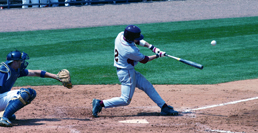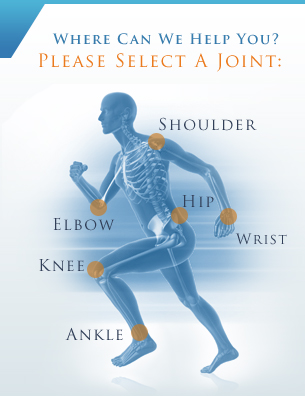
Procedures: Knee
|
|
Knee FAQs
What are some possible causes of knee pain?
As an active, weight-bearing joint, the knee is a source of pain and problems for many people. This pain can be acute or chronic, and may be a result of injury, overuse or growth. It can stem from the tendons, ligaments, bones, cartilage or any other structure within the knee. Some of the common causes of knee pain include:
- Arthritis
- Bursitis
- Dislocated Kneecap
- Meniscal Tear
- Ligament Injuries
- Patellar Tendonitis
What symptoms are typically associated with knee pain?
Patients with a knee condition may experience:
- Constant pain that worsens with activity
- Inability to bend or straighten the knee
- Loss of motion
- Swelling
- Stiffness
- Aching
- Redness
- Deformity around the knee area
- Difficulty walking
Your individual symptoms will vary depending on the cause of the knee pain. It is important to monitor your symptoms and provide your doctor with detailed symptom information so that he or she can make an accurate diagnosis.
How can knee pain be treated?
 The best treatment for knee pain depends on the underlying cause of the symptoms, but may include rest, applying heat or ice, physical therapy, medication or surgery. Surgery is usually reserved for severe cases or those that do not respond to conservative treatments. Surgical treatment for knee pain can include arthroscopy or joint replacement. Your doctor will decide which treatment is best for you after performing a thorough evaluation of your individual condition.
The best treatment for knee pain depends on the underlying cause of the symptoms, but may include rest, applying heat or ice, physical therapy, medication or surgery. Surgery is usually reserved for severe cases or those that do not respond to conservative treatments. Surgical treatment for knee pain can include arthroscopy or joint replacement. Your doctor will decide which treatment is best for you after performing a thorough evaluation of your individual condition.
What is a meniscal tear?
The meniscus is a C-shaped structure made of tough cartilage that rests on each side of the knee in between the thigh and shin bones. This structure helps distribute body weight evenly across the knee and prevents the two bones from rubbing together. Trauma involving a twisted knee or weakened tissue caused by aging can cause the meniscus to tear. A torn meniscus usually causes symptoms such as stiffness, swelling, pain and tenderness in the knee. If a piece of the meniscus breaks off, the knee may pop, slip or lock in place.
How is a meniscal tear treated?
Treatment for a meniscal tear depends on the type, size and location of the tear, but often begins with home treatments such as resting, applying ice and elevating the affected area. Anti-inflammatory medication may also be prescribed to help reduce pain symptoms.
Severe or unresponsive tears may require surgery to repair the condition. Surgery for a meniscal tear is usually done through arthroscopy, during which your surgeon inserts a camera and tiny instruments into the knee to trim or repair the torn portion of the meniscus.
What is the anterior cruciate ligament?
The anterior cruciate ligament (ACL) runs diagonally through the middle of the knee joint and is one of the most commonly injured ligaments in the knee. With three other ligaments, the ACL connects the thigh bone to the shin bone and provides stability and limited joint mobility to the knee.
The ACL is most often injured during high demand sports such as soccer, football and basketball when an athlete makes sudden pivots and turns. Patients may experience a sudden swelling in the joint and feeling that the knee is about to give out, along with a popping sound and pain while walking. Diagnosing this condition is often not possible immediately after the injury, since the swelling can make it difficult to examine.
How is an ACL injury treated?
Treating a torn ACL varies depending on the patient's individual needs. While a torn ACL cannot heal without surgery, elderly patients can often find relief from nonsurgical treatments such as bracing or physical therapy.
Surgery to repair a torn ACL is not usually performed until several weeks after the injury, when swelling and inflammation have subsided. The torn ligament is completely removed and replaced with a new ACL, as simply reconnecting the torn ends will not repair the ligament. The replacement ligament is usually grafted from another part of the knee or hamstring.
What is patellar tendonitis?
 Tendonitis in the knee joint most often affects the patellar tendon, which connects the kneecap to the shin bone and aids in the extension and strength of the knee. Patellar tendonitis occurs when the patellar tendon and surrounding tissues become inflamed and irritated as a result of overuse. This condition often develops from excessive jumping, and is sometimes referred to as "jumper's knee".
Tendonitis in the knee joint most often affects the patellar tendon, which connects the kneecap to the shin bone and aids in the extension and strength of the knee. Patellar tendonitis occurs when the patellar tendon and surrounding tissues become inflamed and irritated as a result of overuse. This condition often develops from excessive jumping, and is sometimes referred to as "jumper's knee".
Patients with patellar tendonitis may experience pain in the kneecap that is worse with activity, and swelling around the knee as well.
How is patellar tendonitis treated?
Treatment for patellar tendonitis usually begins with conservative methods such as rest, applying ice, bracing and anti-inflammatory medications to help reduce symptoms and restore the tendon to its regular state. Surgery is rarely needed to correct this condition, and is only performed on patients with chronic tendonitis that involves a degenerative tendon.









